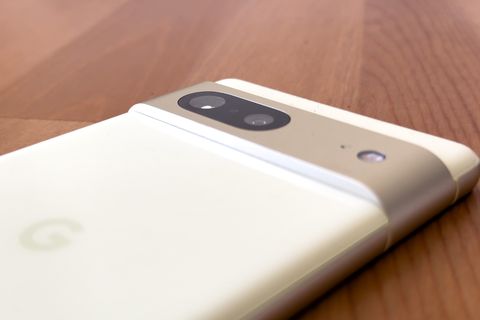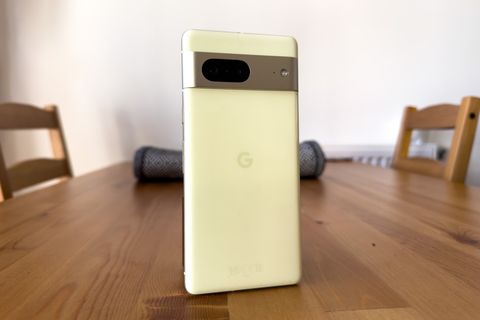Google isn’t reinventing the wheel with the shiny new Pixel 7. It’s a polished and refined upgrade to last year’s Pixel 6. The good news is that we already highly recommend the 2021 variant and its cheaper sibling, the Pixel 6a, and that remains the case when it comes to the new model.
Here you’re getting the best possible Android experience, Google’s Tensor-driven smarts, a terrific camera setup, and a few little refinements that improve the minor drawbacks of the predecessor (yes, the fingerprint sensor is far better).
But (and it’s a crucial but), this one costs £599 while the very comparable Pixel 6 goes for £499 (or less when on offer). Are the iterative upgrades really worth a full £100 more? That’s the big question.
Whichever model you pick, we reckon the Pixel lineup is the way to go for anybody after an Android upgrade without the annoying bloatware that you can find on certain other devices, and the stability and smoothness of Android 13 are enough to make even the most obsessed iPhone diehard think twice about switching.
While the stats show that Google’s handsets still make up only a small portion of all the smartphones out there in the wild, that number is growing faster than other brands and we can report that we’ve spotted an increasing amount of Pixel devices in the hands of our fellow commuters (it helps that the camera bar makes them distinctive!).
After testing it out for just over a week, we think the new Pixel 7 is the best Android smartphone for most people, especially if you don’t need the bigger display, slightly better battery and more advanced cameras of the Pixel 7 Pro.
However, there’s not a huge difference between this and the Pixel 6, which is way more affordable, so we’d still recommend bargain hunters go with the older model until we see a significant price drop on the 7.
Google Pixel 7 key specs
• Screen size: 6.3 inches
• Resolution: 2400 x 1080 pixels
• Processor: Google Tensor G2
• Cameras: Two rear cameras (50MP main and 12MP ultra-wide angle) and 10.8MP front camera
• RAM: 8GB
• Storage space: 128GB or 256GB
• MicroSD card slot: No
• Weight: 197g
Google Pixel 7 design
From the outside, it might look like there’s little difference between the Pixel 6 and the Pixel 7.
Both phones have a clear visual identity with an edge-to-edge “camera bar” on the rear. On the new model, this has changed texture, now in matte aluminium. It looks sleek and classy, although we’re aware this design has its detractors and, yes, it won’t sit flat on the desk without a case.
To be honest, though, a case is essential here, given the slipperiness of the glass on the back of the phone.
There are some changes that are almost imperceptible unless you’re holding the 6 and 7 side-by-side. The new one is a tiny bit smaller with a 6.3-inch (rather than a 6.4-inch) display, and it’s a little lighter than its predecessor too.
We like the colour range, especially the fun “Lemongrass” shade of our review unit. “Kinda Coral” and “Sorta Seafoam” lovers will be disappointed, though, as the 7 doesn’t come in those colours – its other two hues are white or black (or “Obsidian” and “Snow” if you prefer Google lingo).
Google Pixel 7 camera
If you’re looking into buying a Pixel smartphone, it’s safe to say you probably care a lot about how good it is for photography. We’re always snapping away on our phones too, and the good news is that this is yet another brilliant Google camera driven by software.
The iPhone may still be king when it comes to video but it’s not as clear cut when it comes to still photos. The Pixel often delivers results that need less editing and attention before posting on your Instagram feed.
On the actual hardware itself, the Pixel sports the same combination of a 50MP main camera and a 12MP ultra-wide. That main camera will be the go-to option and it delivers excellent results, while there’s a telephoto setting that uses the central portion of the big sensor.
On test, the shots from all the rear cameras were excellent, always detailed, colourful, accurate and contrasty. The main actual hardware upgrade is the higher-resolution front-facing camera, which selfie fans will appreciate.
Google also improved on its “Face Unblur” feature that it added to the camera last year with an overall “Photo Unblur” to rescue your ruined shots no matter what camera they were shot on. You can dig out old snaps shot on your point-and-shoot from 2007 and it should be able to fix the blurriness.
We tested this out and we’re impressed at how good these results are. This editing wizardry is driven by the new chip in the Pixel 7, so it’s one of those features that you can’t enjoy without buying the new phone.
If you’ve got a massive collection of photos you want to repair, the way the unblur addition could bring memories back to life may make it worth the price of the upgrade.
Below we’ve included a selection of photos we’ve shot with the Pixel 7, including some that use the portrait mode and the ultra-wide lens – these are all completely unedited, showing off the colours and clarity that you’ll get without any extra fine-tuning:
Google Pixel 7 cinematic video
Much like the “Cinematic Mode” on iPhone 13 and 14 models, the new Pixels come with a mode that adds blurry “bokeh” to the background of your videos. This is one addition, though, that doesn’t feel quite there yet.
We compared the results we got to videos we shot last year on the iPhone 13 mini, and those from the dinky iPhone look much more natural. The Pixel struggles with subject detection and tracking in this video mode, and the blurry edge around the subject looks a little artificial.
Hopefully, this improves with some software updates in the future.
Google Pixel 7 battery life and processor
Battery life on the Google Pixel 7 is improved due to the addition of Google’s upgraded Tensor G2 chip. On paper, stats boffins may look at the processor and see a relatively minor upgrade, but it has benefits for machine learning and efficiency.
Google boasts about faster performance for low-light photos, the “unblur” feature to fix dodgy snaps and better on-device speech recognition (we tried its transcribing feature and that’s also superb).
Because it’s more efficient, there is a battery life improvement too. We should say that we never had any issues with the Pixel 6, and the solid battery life on the Pixel 7 is impressive. It’s a technically smaller battery, yet still rated to last over 24 hours. Like on the old model, this gets us through a day of normal use with zero issues.
There are two handy quality-of-life improvements worth mentioning too. The first is that Google fixed the temperamental in-display fingerprint reader that’s a bit slow on the Pixel 6 and is now perfect on the Pixel 7. We’ve got no complaints.
And, in addition to that, you’ve now got a face unlock function too. This isn’t as secure or as advanced as a full-on 3D system like Apple’s Face ID (which is reflected in how it can open the phone but not confirm payments or authenticate entry into banking apps), but it’s still more than good enough for most people and there won’t be delays when unlocking your phone.
Google Pixel 7 display
We like the Pixel 7’s display for all the same reasons we like the one on the Pixel 6 – there isn’t all that much of a difference between them. It’s still a stunning, bright and vibrant panel.
Most people will love the smoothness and fluidity of its 90Hz refresh rate, and the implementation of the always-on display is far better here than it is on the more expensive new Apple iPhone 14 Pro.
Whether you’re gaming, scrolling through your TikTok FYP or catching up with the latest episodes of The Rings of Power, you’ll have no problems with this screen.
Google Pixel 7 drawbacks
As mentioned above, the cinematic video is pretty ropey and you’ll probably want to avoid it. And, like on the previous version, there’s no slot for a memory card so you’ll want to decide whether you need the 128GB or 256GB variant you need before you hit “add to basket”.
These aren’t major issues but, for us, the biggest downside is just how much here is comparable to the existing Pixel 6. That one is far better value when you compare both side-by-side. We love the Pixel 7 but if you’re on a budget at all, the 6 is the way to go.
Google Pixel 7 verdict
It should come as no surprise that the Pixel 7 gets a thumbs up from us – it’s an excellent smartphone and, even if we pretend that the Pixel 6 doesn’t exist, it’s still terrific value at its starting price of £599.
We live in a world where the Pixel 6 is still kicking around, though, so we’d still go with that one if you want most of what’s great about a Pixel at a lower price (we’re in a cost-of-living crisis, after all).
If you must have the latest from Google, you can’t go wrong with the polished Google Pixel 7. The design is more refined, it’s got the latest clever features, new photography skills and an improved high-res selfie camera.









